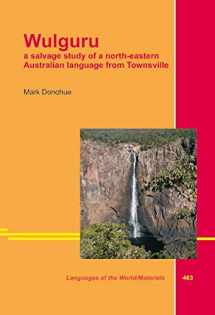
Wulguru. a salvage study of a north-eastern Australian language from Townsville Mark
ISBN-13:
9783895863271
ISBN-10:
3895863270
Author:
Mark Donohue
Publication date:
2007
Publisher:
LINCOM publishers
Format:
Paperback
FREE US shipping
Book details
ISBN-13:
9783895863271
ISBN-10:
3895863270
Author:
Mark Donohue
Publication date:
2007
Publisher:
LINCOM publishers
Format:
Paperback
Summary
Wulguru. a salvage study of a north-eastern Australian language from Townsville Mark (ISBN-13: 9783895863271 and ISBN-10: 3895863270), written by authors
Mark Donohue, was published by LINCOM publishers in 2007.
With an overall rating of 4.3 stars, it's a notable title among other
books. You can easily purchase or rent Wulguru. a salvage study of a north-eastern Australian language from Townsville Mark (Paperback) from BooksRun,
along with many other new and used
books
and textbooks.
And, if you're looking to sell your copy, our current buyback offer is $0.3.
Description
Wulguru was a Pama-Nyungan language typical of the sort found on the northeast coast of Australia; it ceased to be spoken before it was properly documented. Wulguru was spoken in the area around present day Townsville, and also on the islands extending out to Palm Island. The sketch that is presented here has been assembled from the available data, based mainly on a journal kept by Charles Price, a resident of Townsville in the late 19th century; the current work is as complete a record as we are likely to have. Wulguru had a vowel-length distinction; as a result of initial consonant loss, vowels could begin words; further, there were monosyllabic words. Wulguru marked syntactic relations by means of case marking; the ergative showed allomorphy based on syllable count as well as final consonant identity. There were at least three different verbal conjugations, possibly as many as five or six. Verbal agreement was optional, though this might represent second position clitics. The only textual material consists of a few short phrases, as well as the transcription of some songs, and the main text that we have for Wulguru, a translation of The Lord's Prayer. It becomes apparent (after back-translation) that it was not Price himself who assembled the prayer translation, but probably a Wulguru speaker who makes a secret cry against the white invasion of the area.


We would LOVE it if you could help us and other readers by reviewing the book
Book review

Congratulations! We have received your book review.
{user}
{createdAt}
by {truncated_author}


